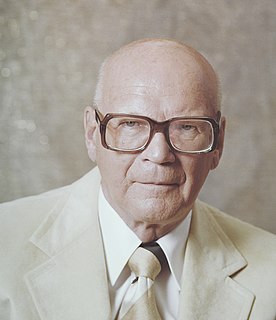
Urho Kaleva Kekkonen, often referred to by his initials UKK, was a Finnish politician who served as the eighth and longest-serving president of Finland from 1956 until 1982. He was the third and most recent president from the Agrarian League/Centre Party. As head of state for nearly 26 years, he dominated Finnish politics, held a large amount of power, won his later elections with little opposition and has often been classified as an autocrat. Nevertheless, he remains a respected figure.

Mauno Henrik KoivistoGOIH was a Finnish politician who served as the ninth president of Finland from 1982 to 1994. He also served twice as the prime minister, from 1968–1970 and again from 1979–1982. He was also the first Social Democratic Party member to be elected President of Finland.

Juho Kusti Paasikivi was the seventh president of Finland (1946–1956). Representing the Finnish Party and the National Coalition Party, he also served as Prime Minister of Finland. In addition to the above, Paasikivi held several other positions of trust, and was an influential figure in Finnish economics and politics for over fifty years.
The Swedish People's Party of Finland is a political party in Finland aiming to represent the interests of the minority Swedish-speaking population of Finland. The party is currently participating in the government of Sanna Marin, holding the positions of Minister of Justice and Minister for Nordic Cooperation and Equality.

Martti Juhani Miettunen, was a Finnish politician who served twice as Finland's prime minister, from 1961 to 1962 and again from 1975 to 1977.
The National Coalition Party is a liberal-conservative political party in Finland.
The Centre Party, officially the Centre Party of Finland, is an agrarian political party in Finland.

Johannes Virolainen was a Finnish politician and who served as 30th Prime Minister of Finland.

Karl-August Fagerholm was Speaker of Parliament and three times Prime Minister of Finland. Fagerholm became one of the leading politicians of the Social Democrats after the armistice in the Continuation War. As a Scandinavia-oriented Swedish-speaking Finn, he was believed to be more to the taste of the Soviet Union's leadership than his predecessor, Väinö Tanner. Fagerholm's postwar career was, however, marked by fierce opposition from both the Soviet Union and the Communist Party of Finland. He narrowly lost the presidential election to Urho Kekkonen in 1956.

Keijo Antero Liinamaa was a Finnish lawyer and politician who served as caretaker Prime Minister of Finland from June to November 1975.

Ahti Kalle Samuli Karjalainen was a Finnish politician. He was a member of the Agrarian League and served two terms as Prime Minister of Finland. He is, however, better known for his period as Minister of Foreign Affairs of Finland. Karjalainen is considered one of the most influential figures in post-war Finnish politics. Like President Urho Kekkonen, Karjalainen attached great importance to Finland's relationship with the Soviet Union.

Sakari Severi Tuomioja was a Finnish politician and diplomat who served as Prime Minister of Finland between 1953-1954 and as Minister for Foreign Affairs between 1951-1952 and as the Governor of the Bank of Finland between 1945–1955. He was also Finland's ambassador in London and Stockholm.
Parliamentary elections were held in Finland on 18 and 19 March 1979.

Kekkonen's first cabinet was the 33rd government of Finland. The cabinet existed from 17 March 1950 to 17 January 1951. It was a minority government. The cabinet's Prime Minister was Urho Kekkonen.
Kekkonen's second cabinet was the 33rd government of Finland, which existed from 17 January 1951 to 20 October 1951. It was a majority government, and its Prime Minister was Urho Kekkonen.
Kekkonen's third cabinet was the 35th government of Finland. The majority government lasted from 20 October 1951 to 9 August 1953. The cabinet’s Prime Minister was Urho Kekkonen.

Keijo Liinamaa's cabinet was the 57th government of Finland. The cabinet existed for 171 days, lasting from 13 June 1975 to 30 November 1975. The Liinamaa cabinet was a caretaker government drawn by President Urho Kekkonen. Due to this government having been instituted by the President, the government included no politically affiliated parties, consisting instead only of government employees. The cabinet’s Prime Minister was Keijo Liinamaa.

The first cabinet of Kalevi Sorsa was the 56th government of Finland. The cabinet's Prime Minister was Kalevi Sorsa. The cabinet was in office from 4 September 1972 to 13 June 1975.

Vieno Simonen was a Finnish politician and farmer. A member of the Agrarian League, she represented Kuopio East in the Parliament of Finland from 1948 to 1962. After serving in deputy ministerial positions in the Kekkonen IV, Törngren, and Fagerholm II cabinets, she was twice appointed as minister of social affairs by prime ministers V. J. Sukselainen and Martti Miettunen, and held the position from 1959 to 1962.

Kerttu Saalasti was a Finnish politician who was the Finland Minister of Education from 1954 to 1956 and from May 1957 to November 1957. She was the first female Minister of Education in Finland, and introduced the legislation that established the University of Oulu. A member of the Agrarian League, Saalasti also represented Oulu in the Parliament of Finland from 1948 to 1962 and from 1966 to 1970.
This page is based on this
Wikipedia article Text is available under the
CC BY-SA 4.0 license; additional terms may apply.
Images, videos and audio are available under their respective licenses.














